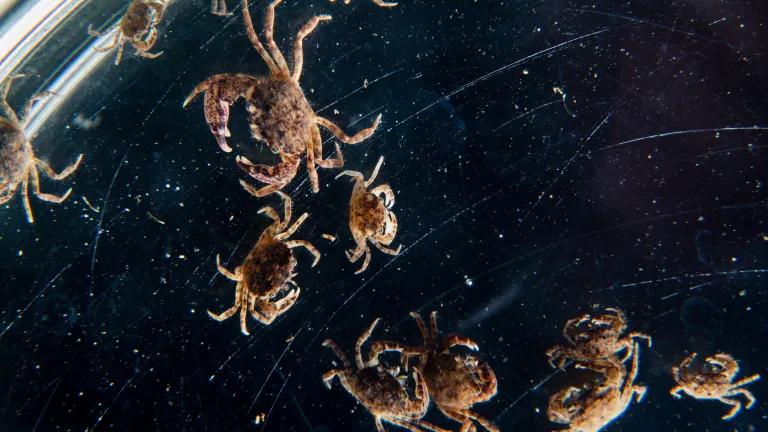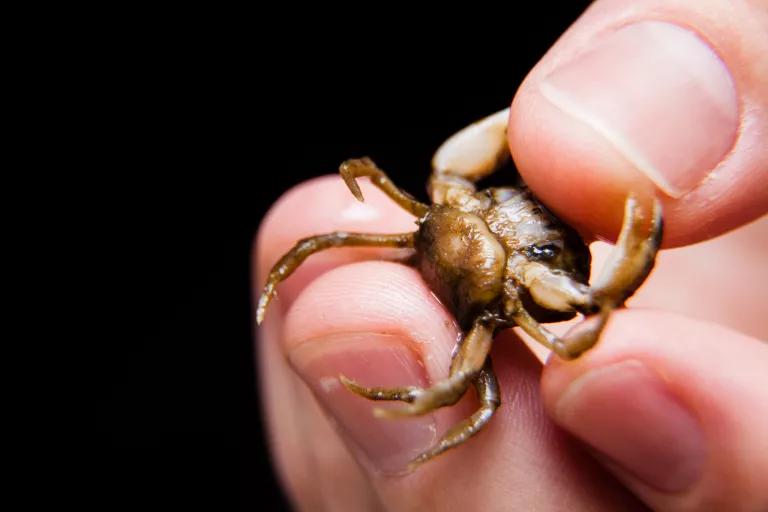Zombie Crabs!
Tiny, invasive East Coast parasites are leaving hordes of the living dead in their wake.

Warning: If The Walking Dead or Invasion of the Body Snatchers gives you nightmares, this probably isn’t a story for you. Sure, the characters aren’t people—they’re thumbnail-size crabs and microscopic barnacles—but it’s a gory tale nonetheless, replete with invasions, castrations, and of course zombie transformations.
Our story begins in the 1960s, when the Chesapeake Bay oyster industry crashed, and bivalves from the Gulf of Mexico were imported to seed commercial oyster reefs. Unbeknownst to anyone at the time, a parasitic barnacle called Loxothylacus panopaei, or Loxo for short, lurked among the alien shells. It’s invisible to the human eye, but local mud crabs quickly became acquainted with the new arrival.

“Loxo turns crabs into zombies and sex slaves,” says biodiversity genomics fellow Carolyn Tepolt, who is studying the invasion at the Smithsonian Environmental Research Center in Maryland.
It’s a grisly process, too. When a female Loxo encounters a vulnerable, recently molted crab, she pierces its soft body and burrows inside. She then grows throughout the crustacean, taking over its nervous system and becoming so intertwined with the crab that it becomes impossible to separate her from her unlucky host. The female Loxo also produces a small sac under the crab’s abdomen. When a male Loxo—basically just a sperm factory—passes by, he fertilizes the sac. With the invasion complete, the crab is rendered infertile. Not only is it unable to produce its own crab offspring, but its entire reason for being becomes to care for parasite babies.

Then things get even creepier. The abdomen of a male crab is shaped like the Eiffel Tower; a female’s abdomen is more shieldlike. As Loxo larvae grow, the sac that contains them expands. In the case of a male crab, this expansion causes the abdomen to spread into more of shield shape, feminizing the poor fella. And both sexes end up protecting the alien spawn as a female would her own developing progeny: by defensively covering and aerating the sac. The result is astounding. Approximately every 10 days, a zombie crab can pump out thousands of parasitic larvae. Nobody knows how long the zombie crabs survive in the wild, but in the lab they last about 45 days.
While the crustaceans are still plentiful—for now—their survival is cause for concern, as they’re an important nutrient source for creatures higher up in the food chain, including other crabs and birds. In some areas of the Chesapeake Bay, Loxo has parasitized up to 90 percent of the mud crab population. Meanwhile, in Loxo’s native range, the Gulf of Mexico, it infects only about 5 percent of the mud crabs, says Tepolt. That’s likely because local crabs have evolved to be less susceptible.

To figure out how and how fast crab populations are adapting to Loxo, Tepolt and a team of volunteers set out to trap crabs from three coastal regions last summer. They dropped milk crates filled with sterilized oyster shells off docks and along the shorelines of the Gulf (where crabs and the parasite coevolved), the mid-Atlantic (where the parasite arrived in the past 10 to 50 years), and New England (where Loxo hasn’t yet arrived). “Mud crabs love the nooks and crannies between oyster shells,” she explains. Tepolt then got busy in her “parasite factory,” intentionally infecting roughly 1,500 nonparasitized crabs and subsequently recording their genetic material.
Now, using high-throughput genetic sequencing, which allows scientists to analyze lots of genetic material at once, she is trying to figure out which genes are effectively turned on or off by the parasite and is hoping to identify the genes that appear to be important for developing resistance. She’s also comparing the sequences of genes between crabs from different regions to see if parasitism alters the order. “Then we can look at how genes change over time as crabs adapt,” she says. Tepolt is particularly curious to see if gene activity and gene sequences in Chesapeake Bay crabs are starting to resemble those of the more resistant crabs of the Gulf. Her findings could help predict how crabs in the Northeast will respond to Loxo, should the parasite make its way to waters farther north.
In the meantime, Tepolt says, there’s one place where she probably won’t discuss her work: as a guest at a dinner table. “It’s not exactly a topic that everyone finds, er, palatable,” she says. We beg to differ. When it comes to party chat, there may be no better answer to “What do you do?” than “I make zombies.”
This article was originally published on onEarth, which is no longer in publication. onEarth was founded in 1979 as the Amicus Journal, an independent magazine of thought and opinion on the environment. All opinions expressed are those of the authors and do not necessarily reflect the policies or positions of NRDC. This article is available for online republication by news media outlets or nonprofits under these conditions: The writer(s) must be credited with a byline; you must note prominently that the article was originally published by NRDC.org and link to the original; the article cannot be edited (beyond simple things such grammar); you can’t resell the article in any form or grant republishing rights to other outlets; you can’t republish our material wholesale or automatically—you need to select articles individually; you can’t republish the photos or graphics on our site without specific permission; you should drop us a note to let us know when you’ve used one of our articles.

Americans Red and Blue Unite Against Trump's Plan to Drill the Atlantic
Are the Gulf's Marine Mammals Fluked?
Drill, Maybe, Drill